Getting rid of gestating sow stalls doesn’t mean getting rid of profitability, says a Manitoba researcher who has looked into two methods of open housing.
But producers might have to switch to a different form of production.
“It is definitely possible for a commercial hog operation to operate profitably using a group housing system,” said Mark Fynn, a graduate student of agribusiness and agricultural economics at the University of Manitoba.
“That being said, group housing systems can vary drastically based on the type of housing and flooring, group management and feeding systems that are used.”
Read Also

Global meat packer prepares for cattle shortage
Brazilian meat packer JBS is preparing for a likely shift in the country’s cattle cycle that could lead to reduced availability of animals for slaughter next year.
Fynn said moving to group housing while keeping partially slatted floors and a slurry manure system was slightly unprofitable.
But a straw-based, solid floor system was “quite profitable,” averaging $60 per sow per year.
Fynn and fellow researchers did not analyze the difference in construction costs between a slurry/slatted barn system and a solid floor barn system, but that “is not expected to be that substantial.”
He also did not analyze the cost of retrofitting existing structures.
Producers are leery of converting because of perceptions that sows will fight in open systems.
Fynn said his research showed that violence can be kept to a minimum if the group membership is stable and the number of animals is not too high for the size of pen.
A straw-based system allowed young sows to have fewer leg, hoof and joint injuries.
“This system managed to reduce turnover and avoid high replacement costs,” said Fynn.
Pr trea ditio I su















